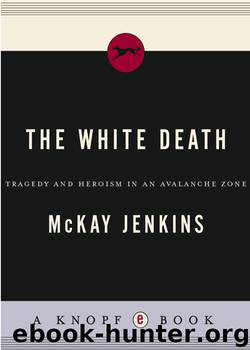The White Death by Mckay Jenkins

Author:Mckay Jenkins [Jenkins, McKay]
Language: eng
Format: epub
ISBN: 978-1-4000-3310-2
Publisher: Knopf Doubleday Publishing Group
Published: 2000-06-07T16:00:00+00:00
The uncertainty among even the most skilled backcountry rangers over the conditions on the upper shoulders of Mount Cleveland was not unusual. Forecasting avalanches, especially for those out in the field, remains a difficult, mysterious business; even physicists, working in the safety of cold-room laboratories with sophisticated computer models, often find themselves scratching their heads. For backcountry skiers and winter mountaineers, for whom avalanches are an ever-present danger, diagnosing the characteristics of a mountain slope is parallel to getting out of the canoe and reading a rapid before descending a particularly dangerous stretch of river. In both cases, one can get a fair sense of the potential danger just by observing flow dynamics. Signs of previous avalanches are an important factor: treeless slopes, broken or scarred trees, or “flag” trees with branches torn off on all but one side are clear indications that masses of snow have torn their way down. Sluffs of small loose-snow avalanches indicate instability, as do large snowballs rolling down a slope. Cracks or fissure lines running horizontally across a slope indicate a slab that has already fractured and may release with the slightest trigger.
There are no guarantees, and no certain safe zones. One might think that hiking or skiing along a sunny slope would be safest, since the wetter snow might be more likely to settle and stabilize. This is true, except after a storm, when the rapid warming may get the snowpack to start creeping downhill; if the creep is sufficient, the elasticity of the snow may become stretched to the point of snapping off a large slab. So, given the choice, particularly after a storm, one might choose a shady slope, since the snow would tend to be cooler and less prone to slide. Perhaps. Cool upper layers, as noted, often draw moisture from those lower down, and contribute to the formation of the faceted or cupped crystals of depth hoar.
A slope that is overloaded by new snow can slide at any time. Even if it hasn’t snowed in weeks, a slope that has had a new layer deposited by wind becomes dramatically less stable. Snow falling off cornices can trigger an avalanche; so can snow falling from the branches of trees. The shape of a slope also matters. Hiking across or just below the hump of a convex slope is trouble, as is hiking anywhere in the upper reaches of a concave bowl. Better in either case to hike low, below possible fracture zones, or above, along a ridgeline that is immune to sliding. Traveling across a steep slope, hikers may find temporary havens from avalanches among outcroppings of rocks or trees, known as “islands of safety.” But if a large slide should suddenly occur uphill—perhaps triggered even by a footstep far below—it could easily flow over and engulf the island and its inhabitants like a tidal wave washing out a tiny atoll. Snow is often weakest next to these little islands, and fractures begun by a step near a “safe” bush may trigger an avalanche that carries away the entire slope.
Download
This site does not store any files on its server. We only index and link to content provided by other sites. Please contact the content providers to delete copyright contents if any and email us, we'll remove relevant links or contents immediately.
Man-made Catastrophes and Risk Information Concealment by Dmitry Chernov & Didier Sornette(4751)
The Revenge of Geography: What the Map Tells Us About Coming Conflicts and the Battle Against Fate by Kaplan Robert D(3604)
Zero Waste Home by Bea Johnson(3299)
COSMOS by Carl Sagan(2962)
In a Sunburned Country by Bill Bryson(2954)
Good by S. Walden(2923)
The Fate of Rome: Climate, Disease, and the End of an Empire (The Princeton History of the Ancient World) by Kyle Harper(2444)
Camino Island by John Grisham(2394)
A Wilder Time by William E. Glassley(2368)
Organic Mushroom Farming and Mycoremediation by Tradd Cotter(2315)
Human Dynamics Research in Smart and Connected Communities by Shih-Lung Shaw & Daniel Sui(2182)
The Ogre by Doug Scott(2121)
Energy Myths and Realities by Vaclav Smil(2069)
The Traveler's Gift by Andy Andrews(2019)
Inside the Middle East by Avi Melamed(1947)
Birds of New Guinea by Pratt Thane K.; Beehler Bruce M.; Anderton John C(1916)
Ultimate Navigation Manual by Lyle Brotherton(1772)
A History of Warfare by John Keegan(1724)
And the Band Played On by Randy Shilts(1623)
